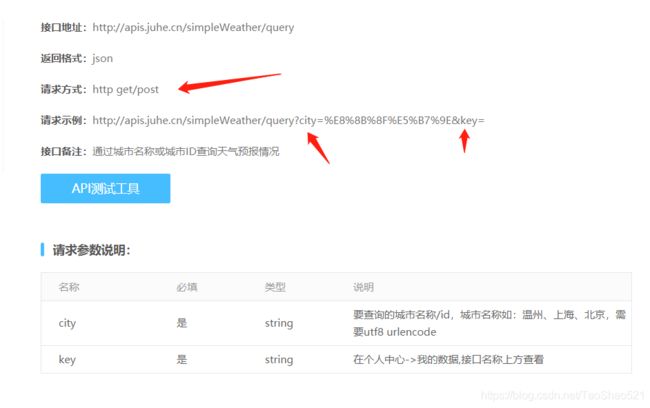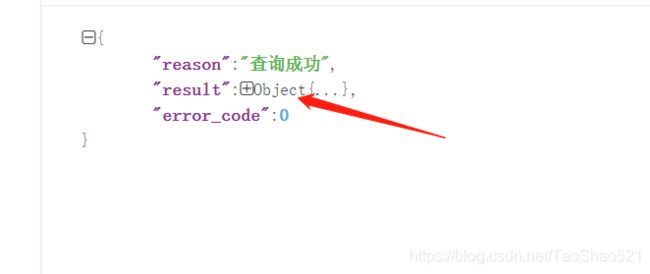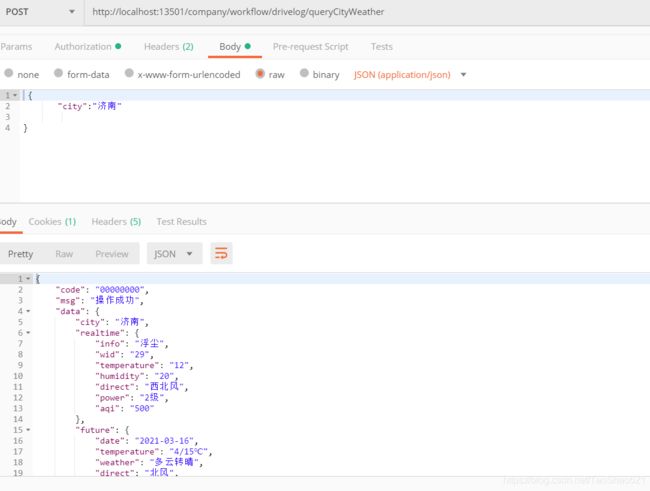用RestTemplate调用第三方提供的API接口
首先按照惯例分享一个提供免费接口的网站:
聚合数据
直接点击去自己注册个账号申请个免费的接口测试
今天用RestTemplate调一个天气预报的接口

申请之后记住这个key后面拼装url会用
建议直接写在配置文件里
先看API文档介绍

很清晰看到该接口请求方式支持get或者post
在看请求示例 :
后面带着两个请求参数 这个地方这两个参数顺序前后无所谓
下面直接来代码:
先弄个key的属性类
/**
* 类说明:
* 〈天气预报接口key〉
*
* @Author: wlt
* @Date: 2021/3/15 10:11
*/
@Data
public class WeatherProp extends BaseBean {
/**
* 调用接口key
*/
private String key;
}
yml配置文件里需要加上
pangu-weather:
weatherprop:
key: xxxxxxxxxxxxxxxx
然后配置类
/**
* 类说明:
* 〈天气接口属性配置〉
*
* @Author: wlt
* @Date: 2021/3/15 10:36
*/
@Configuration
public class ApplicationWeatherConfig {
@Bean
@ConfigurationProperties(prefix = "pangu-weather.weatherprop")
public WeatherProp weatherProp() {
return new WeatherProp();
}
}
以上就可以在启动的时候这个属性类就会当成一个bean注入到容器里了
接下来就是拼装这个url调用了
/**
* 类说明:
* 〈天气预报处理程序〉
*
* @Author: wlt
* @Date: 2021/3/15 10:04
*/
@Slf4j
@Component("weatherHandler")
public class WeatherHandler implements InitializingBean {
/**
* 调用聚合数据接口应答errcode: 0 :请求成功
*/
public static final int RPC_CODE_SUCCESS = 0;
/**
* 调用聚合数据接口应答errcode: 207301 :错误的查询城市名
*/
public static final int RPC_CODE_WRONG_CITY = 207301;
/**
* 调用聚合数据接口应答errcode: 207302 :查询不到该城市的相关信息
*/
public static final int RPC_CODE_NOT_FOUND_CITY = 207302;
/**
* 调用聚合数据接口应答errcode: 207303 :网络错误,请重试
*/
public static final int RPC_CODE_NETWORK_ERROR= 207303;
@Resource(name = "weatherProp")
private WeatherProp weatherProp;
@Resource(name = "restTemplate")
private RestTemplate restTemplate;
/**
* 请求地址
*/
private String url;
@Override
public void afterPropertiesSet() throws Exception {
StringBuilder urlSb = new StringBuilder();
urlSb.append("http://apis.juhe.cn/simpleWeather/query?");
urlSb.append("key=").append(weatherProp.getKey());
this.url = urlSb.toString();
}
/**
* 功能描述:
* <查询天气>
* @Param [city]
* @return 应答消息
* @Author: wlt
* @Date: 2021/3/15 11:10
**/
public WeatherVO weather(String city) {
log.debug("param city : {}", city);
String reqUrl = url + "&city=" + city;
System.out.println(reqUrl);
String responseStr = restTemplate.getForObject(reqUrl, String.class);
log.debug("code: {}, responseStr : {}", city, responseStr);
WeatherVO weather = JsonUtil.readValue(responseStr, WeatherVO.class);
return weather;
}
}
其实就是这么一句话完成了调用
String responseStr = restTemplate.getForObject(reqUrl, String.class);
这个地方得注意啊API返回的JSON示例
{
"reason": "查询成功",
"result": {
"city": "苏州",
"realtime": {
"temperature": "4",
"humidity": "82",
"info": "阴",
"wid": "02",
"direct": "西北风",
"power": "3级",
"aqi": "80"
},
"future": [
{
"date": "2019-02-22",
"temperature": "1/7℃",
"weather": "小雨转多云",
"wid": {
"day": "07",
"night": "01"
},
"direct": "北风转西北风"
},
{
"date": "2019-02-23",
"temperature": "2/11℃",
"weather": "多云转阴",
"wid": {
"day": "01",
"night": "02"
},
"direct": "北风转东北风"
},
{
"date": "2019-02-24",
"temperature": "6/12℃",
"weather": "多云",
"wid": {
"day": "01",
"night": "01"
},
"direct": "东北风转北风"
},
{
"date": "2019-02-25",
"temperature": "5/12℃",
"weather": "小雨转多云",
"wid": {
"day": "07",
"night": "01"
},
"direct": "东北风"
},
{
"date": "2019-02-26",
"temperature": "5/11℃",
"weather": "多云转小雨",
"wid": {
"day": "01",
"night": "07"
},
"direct": "东北风"
}
]
},
"error_code": 0
}
/**
* 类说明:
* 〈返回json数据〉
*
* @Author: wlt
* @Date: 2021/3/15 10:02
*/
@Data
public class WeatherVO extends BaseBean {
private static final long serialVersionUID = 6788688600990722529L;
/**
* <返回码,0为查询成功>
**/
private int error_code;
/**
* <返回说明>
**/
private String reason;
/**
* <返回结果集>
**/
private Object result;
}
接下来就是Controller
注意我用的是DDD领域驱动设计模式写起来很麻烦 我就简单复制下代码你们参考一下即可
/**
* 功能描述:
* <根据城市查询天气>
* @Param [form]
* @return 应答消息
* @Author: wlt
* @Date: 2021/3/15 14:12
**/
@PostMapping(path = "/company/workflow/drivelog/queryCityWeather", produces = MediaType.APPLICATION_JSON_UTF8_VALUE)
public ResponseMessage<WeatherDTO> queryCityWeather(@RequestBody WeatherForm form) {
ResponseMessage<WeatherEntity> result = drivelogAppService.queryCityWeather(form);
if (ResponseCheckUtil.failed(result)) {
return ResponseMessageUtil.genResult(result.getCode(), result.getMsg());
}
WeatherDTO weatherDTO = DrivelogAssembler.toWeatherDTO(result.getData());
return ResponseMessageUtil.genSuccessResult(weatherDTO);
}
APPService代码
/**
* 功能描述:
* <根据城市查询天气>
* @Param [city]
* @return 应答消息
* @Author: wlt
* @Date: 2021/3/15 11:23
**/
public ResponseMessage<WeatherEntity> queryCityWeather(WeatherForm form) {
return drivelogDomainService.queryCityWeather(form);
}
DomainService代码
/**
* 功能描述:
* <根据城市查询天气>
* @Param [city]
* @return 应答消息
* @Author: wlt
* @Date: 2021/3/15 11:23
**/
public ResponseMessage<WeatherEntity> queryCityWeather(WeatherForm form) {
//调聚合数据接口查询天气预报
WeatherVO response = weatherHandler.weather(form.getCity());
Integer errorCode = Integer.valueOf(response.getError_code());
if (errorCode != WeatherHandler.RPC_CODE_SUCCESS) {
Res01012Weather res01012Weather = weatherMap.get(errorCode);
if (res01012Weather != null) {
return ResponseMessageUtil.genResult(res01012Weather);
}
return ResponseMessageUtil.genFailResult();
}
//object转实体类
Object result = response.getResult();
ObjectMapper objectMapper = new ObjectMapper();
WeatherEntity weatherEntity = objectMapper.convertValue(result, WeatherEntity.class);
return ResponseMessageUtil.genSuccessResult(weatherEntity);
}
@Override
public void afterPropertiesSet() throws Exception {
weatherMap = new HashMap<>();
weatherMap.put(WeatherHandler.RPC_CODE_WRONG_CITY,Res01012Weather.RPC_CODE_WRONG_CITY);
weatherMap.put(WeatherHandler.RPC_CODE_NOT_FOUND_CITY,Res01012Weather.RPC_CODE_NOT_FOUND_CITY);
weatherMap.put(WeatherHandler.RPC_CODE_NETWORK_ERROR,Res01012Weather.RPC_CODE_NETWORK_ERROR);
}
我把API上的错误码改成了我们自己项目设定的错误码
前面需要定义一个全局的map
private Map
解释:
afterPropertiesSet这个方法来自接口InitializingBean
源码注释:
设置所有bean属性后,由包含的{@code BeanFactory}调用
并满意{@link BeanFactoryAware},{@ code ApplicationContextAware}等。
此方法允许Bean实例对其整体执行验证 设置了所有bean属性后,进行配置和最终初始化。 如果配置错误(例如无法设置 必要属性),或者如果初始化由于任何其他原因而失败
测试接口:
控制台打印日志


